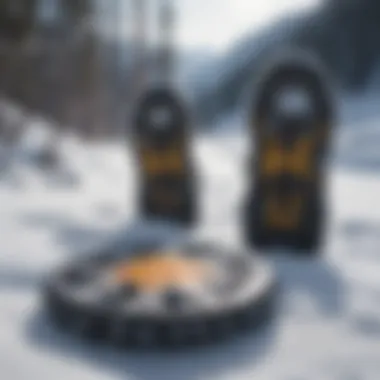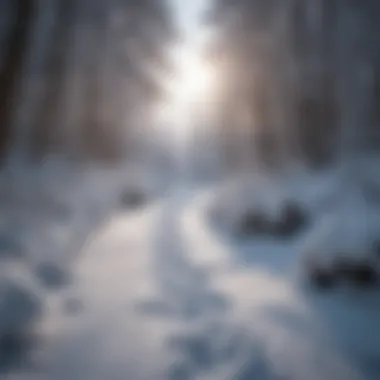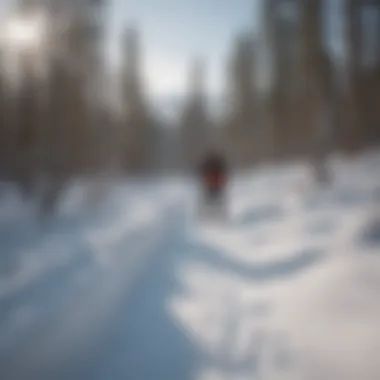Discovering Winter Wonderland: Snowshoeing in D.C.


Intro
In Washington, D.C., winter transforms the scenery into a striking blend of picturesque white vistas and urban charm. Snowshoeing serves as a bridge, connecting residents with the enchanting winter landscape amid iconic monuments and parks. This article thoroughly investigates the snowshoe experience in D.C., shedding light on essential gear, prime locations for exploration, safety considerations, and the broader implications of winter sports on environmental stewardship. It aims to engage both enthusiasts who seek adventure and novices curious about how to navigate the snow-laden surroundings.
Equipment and Gear
Snowshoeing is not just about strapping on shoes and stepping into the snow; having the right equipment is vital for an enjoyable experience. Essential gear includes snowshoes, poles, appropriate clothing, and safety gear. Snowshoes themselves come in various styles, including recreational and backcountry models. Each type has traits suited for different terrains and snow conditions.
You might consider brands like MSR, Tubbs, and Atlas, all well-regarded in the snowshoe community. For beginners, MSR Lightning Ascent snowshoes offer a good balance of performance and user-friendliness. Meanwhile, Atlas 1030 provides added durability and grip, making it a solid choice for urban exploration as well as more rugged trails.
In addition to footwear, appropriate clothing can greatly enhance comfort and performance. Layering is essential; thermal base layers, breathable mid-layers, and weather-resistant outer layers work best. Accessories such as gloves, hats, and moisture-wicking socks help in temperature regulation.
For maintenance, it is critical to clean the snowshoes after use, especially when coming from salt-treated pathways. This reduces corrosion and prolongs the lifespan of the equipment. Keep an eye on the traction frames and bindings; replacing them when worn out ensures safe use.
Techniques and Training
As anyone who has tried snowshoeing knows, mastering certain techniques can significantly enhance the experience. Beginners often start with the basic walking motion, but advanced techniques like running or traversing uneven terrain can provide even greater enjoyment. Practicing stepping sideways or uphill can build necessary skills.
Training routines for strength and endurance can include exercises such as lunges, squats, and core workouts. Focusing on agility can also improve one's ability to navigate tricky snow-covered paths. Trainers often suggest incorporating hiking and aerobic activities into a regular schedule to build stamina.
Learning from seasoned athletes can provide valuable insights. They've offered tips on pacing oneself, adjusting stride length, and seeking balance to avoid stumbling.
Safety and Risk Management
Engaging in snowshoeing carries its risks, despite being a generally safe activity. Hazard awareness is crucial. Potential risks include falling, getting lost, or being exposed to extreme weather conditions. A safety protocol should always be in place, which includes checking weather forecasts before heading out.
It's advisable to carry a map or GPS device and inform someone of your planned route. Additionally, dressing in layers is not merely for comfort; it also plays a key role in preventing hypothermia. Bringing a first aid kit can help manage minor injuries on the go.
Key Safety Tips
- Stay hydrated, even in cold weather.
- Always be aware of your surroundings and typical hazards.
- Avoid venturing into unfamiliar areas without proper guidance or preparation.
"The right preparation leads to a safer and more enjoyable snowshoeing experience. Always prioritize safety."
Events and Competitions
While D.C. may not be renowned for snowshoeing competitions, various regional events welcome enthusiasts to participate. Annual gatherings often occur in nearby parks like Rock Creek Park or Great Falls. These include casual races and community meet-ups, where individuals can exchange tips and experiences.
Local organizations sometimes orchestrate winter fun days that incorporate snowshoeing along with other winter sports. Such events allow participants to develop their skills in a supportive environment and foster community bonds among snowshoe enthusiasts.
Lifestyle and Community
Snowshoeing in D.C. serves not just as a sport but as a lifestyle choice that encourages a deeper connection to nature during winter months. The community around this activity is tight-knit, with many local groups offering organized outings. Whether through official meet-ups or informal gatherings, these connections enrich the experience.
Finding balance between snowshoeing and a healthy lifestyle is essential. Engaging in outdoor activities, even in winter, promotes mental well-being, and connecting with like-minded individuals can be incredibly fulfilling. Starting a routine that involves regular outdoor activities fosters both physical and emotional health.
This guide stands as a resource for anyone interested in snowshoeing, revealing the opportunities available in Washington, D.C. It celebrates the beauty of engaging with winter sports while taking advantage of urban contexts. From gear choices to community involvement, this experience brings unique enjoyment during colder months.
Preamble to Snow Shoe Adventures in D.C.
Snow shoe adventures in Washington, D.C. present a unique way to engage with winter landscapes while exploring the urban terrain. As people seek outdoor activities during colder months, snowshoeing stands out due to its accessibility and the physical benefits it offers. It combines exercise with enjoyment of nature, drawing both locals and visitors.
The significance of snowshoeing in D.C. lies in its potential to connect individuals to both history and the environment. The city’s monuments, parks, and trails become more than scenic views in winter; they turn into vibrant venues for sport and recreation. Not only does snowshoeing provide an opportunity for physical activity, but it also allows participants to appreciate the historical context of the area, making it more than just a pastime.


As we examine this topic, it's necessary to consider various factors. The mechanics behind snowshoeing should be clearly understood. This ensures proper engagement and safety on the trails. Additionally, the history of shoeing techniques adds depth to the experience, revealing the evolution of this activity.
Understanding various factors can elevate the snowshoeing experience. These include:
- Physical health benefits: Increased cardiovascular fitness and muscle engagement.
- Connection to environment: Being outdoors improves mood and mental health.
- Cultural and historical insights: Exploring the significance of D.C.’s landmarks contributes to a deeper environment awareness.
"Snowshoeing transforms our winter outings. It enhances appreciation for nature while also improving physical endurance."
Table of Contents:
- Understanding Snow Shoe Mechanics
- Historical Context of Snow Shoeing
This section sets the foundation for a comprehensive view of snowshoeing in D.C. Each aspect covered here enriches the overall narrative and provides a deeper understanding of the sport.
Essential Gear for Snow Shoeing
When embarking on the snow shoeing journey in Washington, D.C., it is crucial to understand that the right equipment plays a significant role in both performance and safety. Selecting suitable gear can elevate the experience of navigating winter terrain, making it more enjoyable and less prone to mishaps.
Choosing the Right Snow Shoes
Selecting the proper snow shoes is pivotal. The market offers a range of options, each designed for different types of snow conditions and user experience. Factors to consider when choosing snow shoes include:
- Type of Terrain: Some snow shoes are broader for softer snow, while others are narrower for packed trails.
- Weight Capacity: It is essential to check the indicated weight limit on snow shoes to ensure adequate flotation.
- Binding Features: Look for snow shoes with adjustable bindings for a snug fit, which aids in stability.
- Ease of Use: Some models offer a simple step-in design, while others require more effort to strap on.
Selecting the right snow shoes greatly affects comfort and efficiency.
Apparel Considerations
Dressing appropriately for snow shoeing is equally important. The right apparel not only keeps you warm but also ensures you can move freely. Key considerations include:
- Layering: Use a base layer made of moisture-wicking fabric to keep sweat away from the skin. A mid-layer should provide insulation, while an outer waterproof layer protects against wind and snow.
- Footwear: Choose insulated, waterproof boots that allow for quick movements and keep your feet warm.
- Accessories: Don’t forget to wear a hat, gloves, and a scarf. These retain body heat effectively.
Wearing the correct apparel enhances overall enjoyment of snow shoeing in chilly conditions.
Accessories for Optimal Performance
Accessories can further enhance the snow shoeing experience. Investing in a few essential items can drastically improve comfort and safety while on the trails. Important accessories to consider include:
- Trekking Poles: These can provide additional stability and help manage balance on uneven terrain.
- Gaiters: These prevent snow from getting into your shoes, keeping your socks dry.
- Hydration Packs: Staying hydrated is essential. Use packs that are easy to access for quick hydration.
- Sunglasses or Goggles: Protecting your eyes from glare and UV rays is vital in snowy conditions.
Using the right accessories contributes significantly to a successful day outside.
Preparing adequately by selecting the right gear ensures not only a pleasurable outing but also a safer experience on snowy landscapes.
Popular Snow Shoe Trails in D.C.
Exploring popular snow shoe trails in Washington, D.C., provides an essential understanding of where urban landscapes transform into winter wonderlands. The trails selected for this experience do more than just offer a pathway; they present an opportunity to appreciate nature in a unique urban context. Each trail possesses characteristics that attract snow shoe enthusiasts, ranging from scenic views to the challenge of the terrain. By diving into these locations, one can understand the social and environmental implications of using these spaces for recreation during the winter months.
National Mall as a Snow Shoe Destination
The National Mall stands as an iconic symbol of American history and culture, and when covered in snow, it transforms into a spectacular setting. Snow shoeing here offers views of important monuments and memorials, including the Washington Monument and Lincoln Memorial. The flat terrain is accessible, making it a favorable choice for beginners and families. The experience of gliding past significant landmarks while enjoying the beauty of a winter blanket can be quite engaging.
Walking along the Mall, participants can enjoy the tranquility that snow brings. A gentle crunch underfoot contrasts with the busy ambiance of D.C. during warmer months. In winter, it’s a serene escape. Moreover, this location often becomes a social hub, where snow shoe enthusiasts gather, fostering a sense of community among fellow winter sports lovers. But keep in mind, snow shoeing on the Mall requires respect for the preservation of this historical area.


Rock Creek Park: A Natural Retreat
Rock Creek Park serves as an urban oasis that invites snow shoeers to immerse themselves in nature, right in the heart of Washington, D.C. The park offers a diverse range of trails that cater to various skill levels. Some routes lead through wooded areas while others circle around open spaces, providing ample opportunities to enjoy scenic views.
What makes Rock Creek Park appealing is its vast space, allowing one to escape the hustle and bustle of the city. Wildlife encounters are also a bonus. You may spot birds or even deer as you navigate the trails. The park typically has well-used paths, making it easier to identify suitable areas for snow shoeing. Yet, caution is necessary as trails can become mixed with challenging terrains, requiring awareness and skill to navigate effectively.
Parks and Recreation Areas for Winter Sports
In addition to the National Mall and Rock Creek Park, D.C. is home to several parks and recreation areas that support winter sports. These locations provide well-maintained paths, typically marked and cleared for safe navigation, making them ideal for snow shoeing and related activities.
Key parks and recreation areas include:
- Meridian Hill Park: Known for its terraced landscape, this park offers exciting views and unique spaces to explore while snow shoeing.
- Kenilworth Park and Aquatic Gardens: This area features flat terrain and beautiful gardens, making it a picturesque setting during winter.
Visiting these parks not only allows for snow shoeing but also promotes outdoor physical activity during the colder months. It enhances the experience of winter sports in urban settings while encouraging health and well-being.
"Winter sports like snow shoeing enhance the connection between nature and urban life."
Overall, the snow shoe trails in D.C. present varied experiences that merge outdoor activity with the cultural depth of the city. Understanding these trails offers insights into how urban residents can engage with nature during winter, fostering a spirit of adventure amidst the backdrop of historical significance.
Safety Considerations in Snow Shoeing
Snowshoeing can be an enjoyable and invigorating winter sport, but it also comes with its own set of safety considerations. It is crucial to understand the potential risks involved and how to mitigate them. Proper knowledge and preparation enhance safety, allowing enthusiasts to focus on the thrill of the experience while minimizing dangers.
Winter conditions can change rapidly, and snowshoeing in unfamiliar areas can present challenges. Hazards include shifting weather patterns, icy trails, and changes in visibility. Awareness of these challenges is essential for maintaining a safe environment. Taking proactive measures not only assures physical safety but also enriches the overall experience.
Understanding Winter Conditions
When snowshoeing, understanding winter conditions is pivotal. Temperatures can drop unexpectedly, leading to potential hypothermia or frostbite. It is advisable to check the weather forecast before heading outdoors and to monitor conditions in real time. Factors such as wind chill can make seemingly mild weather treacherous.
- Familiarize Yourself with the Terrain: Pay attention to trail conditions. Fresh snow can conceal obstacles like rocks and branches. Likewise, icy patches can significantly increase the risk of slips.
- Dress Appropriately: Wearing layered clothing traps heat and keeps moisture away from the body. This is vital in preventing hypothermia.
- Be Mindful of Navigation Tools: Carrying a compass and map or using GPS devices can help maintain orientation in the changing winter landscape.
"Preparation and knowledge are as vital as technique when it comes to snowshoeing.
First Aid Essentials for Snow Shoers
First aid knowledge is essential for snowshoers, whether they are veterans or new to the sport. An accident can happen, no matter how cautious one may be. Basic first aid supplies and training can make a critical difference. Here are some key essentials:
- First Aid Kit: A kit should include items like adhesive bandages, antiseptic wipes, gauze pads, and pain relief.
- Emergency Blanket: This lightweight item can prevent heat loss for someone who becomes ill or injured in the cold.
- Communication Device: A mobile phone or other communication device is vital, especially in remote areas. Let someone know your route and expected return time.
- Knowledge of Basic First Aid: Learning how to treat common injuries such as sprains, fractures, or hypothermia can greatly benefit self and companions.
Overall, your safety while snowshoeing depends heavily on awareness and preparation. Evaluating the environment and being equipped with the necessary tools can transform a fun day on the trails into a safe adventure.
Environmental Impact of Snow Shoeing
Understanding the environmental impact of snow shoeing is essential for ensuring that this winter activity can be enjoyed sustainably. Snow shoeing, while allowing individuals to traverse snow-covered landscapes, can also bring about certain challenges to natural ecosystems. The balance between recreation and conservation is often delicate, especially in urban environments like Washington, D.C. Therefore, it is vital to highlight specific elements that can boost responsible snow shoeing practices while preserving the surroundings.
Sustainable Practices for Snow Shoers
Sustainable practices are fundamental for minimizing the negative effects of snow shoeing on the environment. Here are key practices:
- Plan Your Route: Select trails that are designated for snow shoeing. This helps in preventing damage to vegetative areas that are fragile during winter.
- Stay on Marked Paths: When snow shoeing, keeping to established paths limits disturbance to the ground, plant life, and any animal habitats in the vicinity.
- Limit Group Sizes: Smaller groups can reduce impact on trail conditions and wildlife. This is especially important in conserved areas where ecosystems can be easily disrupted.
- Pack Out Trash: Ensure to take all waste with you when you leave. Litter can harm wildlife and detract from the natural beauty of snow-covered landscapes.
- Use Eco-Friendly Gear: Opt for snow shoes made from sustainable materials. Brands that focus on ecological responsibility tend to offer products that are less harmful to the environment.
These practices not only support the environment but also enhance the overall snow shoeing experience by fostering a deeper connection to nature.


Conservation Efforts in Urban Snow Shoe Regions
In urban areas like Washington, D.C., there is an increased emphasis on conservation efforts to ensure that winter sports can thrive alongside environmental stewardship. Local organizations and volunteers are often engaged in activities such as:
- Habitat Restoration: Many groups focus on restoring natural habitats, especially those affected by recreational activities. This might involve planting native species or removing invasive plants from the area.
- Educational Campaigns: Public awareness campaigns aim to educate snow shoe enthusiasts about the local ecosystems, helping them understand their role in preserving these natural spaces.
- Partnerships with Parks: Collaboration with park services ensures that trails are maintained properly and that conservation measures are integrated into urban planning.
- Community Clean-Up Events: Many organizations host events focused on cleaning city trails after the winter season to prepare for spring and prevent litter from affecting local wildlife.
"Conservation is not merely a duty; it is our responsibility to preserve the land for future generations."
Sustaining a balance between enjoyment and ecological mindfulness is critical for ensuring that snow shoeing remains a viable activity in urban environments. By adopting sustainable practices and engaging with ongoing conservation efforts, snow shoeers can help protect the beauty of Washington, D.C.'s winter landscapes.
Community Engagement and Snow Shoe Events
Community engagement plays a pivotal role in fostering an environment where snowshoeing can thrive in urban settings like Washington, D.C. By connecting enthusiasts to local organizations, events, and educational offerings, participants can find greater enjoyment and awareness surrounding this winter sport. These connections not only enhance personal experiences but also encourage a sense of community among practitioners.
Local Organizations Supporting Snow Shoeing
Various local organizations are dedicated to promoting snowshoeing and winter sports within D.C. They often serve as resource hubs, offering essential information on trails, gear, and safe practices. One notable organization is the Washington, D.C. Department of Parks and Recreation, which provides maintained trails and organizes events to raise awareness about winter sports. Moreover, groups like the D.C. Snowshoe Club engage members through activities that strengthen community ties.
These organizations frequently host meet-ups where enthusiasts can share experiences, tips, and companionship. This is particularly valuable for novices who may feel overwhelmed by the complexities of winter sports. Engaging with experienced snowshoers can demystify the sport and encourage beginners to participate confidently.
Annual Snow Shoe Competitions
Annual snowshoe competitions are a significant highlight in the local winter sports calendar. These events not only showcase athletic skill but also draw together participants from diverse backgrounds to celebrate snowshoeing. Competitions, such as the D.C. Snowshoe Sprint, typically involve short races designed for both individuals and teams. They emphasize speed and technique, appealing to adrenaline seekers and competitive athletes.
The exhilaration of competition fosters a spirited atmosphere, promoting camaraderie among participants. They serve as platforms for sharing experiences, achievements, and enthusiasm for snowshoeing. Organized by local sports clubs, these events often include categories catering to different skill levels, ensuring both seasoned athletes and newcomers can find a place to compete.
Workshops and Educational Programs
Workshops and educational programs are integral to encouraging safe and effective snowshoeing practices. Many local organizations offer beginner workshops that cover essential topics such as gear selection, safety considerations, and proper techniques. These sessions comprise both theoretical components and practical experiences, providing a comprehensive introduction to the sport.
Moreover, expert-led workshops can significantly enhance a participant's skills. Some organizations partner with experienced snowshoers to provide advanced training on techniques, fitness, and trail etiquette. Attending these sessions is beneficial for not only skill development but also connecting with other members of the community.
Future of Snow Shoeing in Urban Environments
The future of snow shoeing in urban environments like Washington, D.C., carries both potential and challenges. Understanding this future is essential for enthusiasts and communities. As the popularity of winter sports grows, cities look for ways to accommodate outdoor activities.
Snowshoeing offers unique benefits in urban settings. These include making winter recreational activities accessible to a larger population. Residents can enjoy nature without needing to travel far. This can lead to healthier lifestyles and increased social interaction among community members. Engaging with nature in a snowy landscape can improve mental well-being and encourage an active lifestyle.
Evolving Trends in Winter Sports
In recent years, winter sports have seen many changes in urban areas. Many are turning to more inclusive and diverse activities. Snowshoeing fits perfectly within this trend. This sport requires minimal gear. It is easy for beginners to learn. Therefore, many non-traditional participants are drawn to it.
Local governments recognize the rising interest. They may invest in better infrastructure. This includes dedicated trails and rental service for snow shoes. This investment not only supports existing athletes but also attracts newcomers who are curious about winter sports.
To enhance participation, organizations are offering various community events. For instance, guided snowshoe tours are becoming more common. They help new users feel comfortable while navigating trails.
Likewise, social media becomes a key tool in promoting snowshoeing activities. People share their experiences, which encourages others to join in. Online communities become vital platforms where information and experiences are exchanged.
Innovations in Snow Shoe Technology
Technology plays a crucial role in the evolving experience of snowshoeing. Innovations have made equipment lighter and more durable. Modern materials improve performance, making it easier to maneuver across snowy terrains.
Recent advancements also include features that enhance comfort and support. Companies are focusing on creating better bindings and improved traction systems for the shoes. These improvements minimize the risk of slipping and falling. This detail is vital, especially for those less experienced.
Additionally, there is a trend towards eco-friendliness in manufacturing. Sustainable practices are increasingly important to users who care about the environment. For that reason, brands are exploring recycled materials and responsible sourcing. This resonates well with consumers who value sustainability.
"The integration of innovative technology with traditional snowshoeing creates a more enjoyable and accessible experience for everyone."
As winter sports continue to grow urban landscapes will adapt. With community involvement and technological innovations, the future of snow shoeing appears promising. This ensures that more people can participate in the joy of exploring winter in their city.















